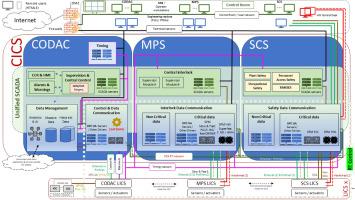Bridging open and proprietary control frameworks for fusion facilities: EPICS – Industrial SCADA integration in the CODAC system of IFMIF-DONES
IF 2
3区 工程技术
Q1 NUCLEAR SCIENCE & TECHNOLOGY
引用次数: 0
Abstract
This paper presents an architectural approach for the Control, Data Access, and Communication (CODAC) system within the framework of the IFMIF-DONES (International Fusion Materials Irradiation Facility DEMO Oriented Neutron Source) control systems. This study focuses on the integration of the most widely adopted SCADA frameworks with state-of-the-art industrial automation standards in particle accelerator environments. The interoperability between EPICS and commercial control frameworks based on OPC UA is particularly emphasized, enabling a hybrid control ecosystem that leverages the strengths of both domains.The architecture enhances flexibility, scalability, and standardization across all systems and subsystems involved in supervision and control tasks. By facilitating seamless communication and modularity, it supports the use of both open-source and proprietary technologies while ensuring long-term maintainability and adaptability. The paper includes a review of comparable systems at other large-scale facilities, an evaluation of integration strategies, and a detailed discussion of the resulting CODAC architecture, highlighting its impact on the overall efficiency and interoperability of the IFMIF-DONES Central Instrumentation and Control Systems (CICS). This study aims to offer a complementary perspective on the control system architecture for IFMIF-DONES, exploring the potential integration of industrial SCADA frameworks alongside EPICS.

连接融合设施的开放和专有控制框架:EPICS -工业SCADA集成在IFMIF-DONES的CODAC系统中
本文提出了IFMIF-DONES(国际聚变材料辐照设施演示导向中子源)控制系统框架内的控制、数据访问和通信(CODAC)系统的体系结构方法。本研究的重点是粒子加速器环境中最广泛采用的SCADA框架与最先进的工业自动化标准的集成。特别强调了EPICS和基于OPC UA的商业控制框架之间的互操作性,从而实现了利用两个领域优势的混合控制生态系统。该体系结构增强了监督和控制任务中涉及的所有系统和子系统的灵活性、可伸缩性和标准化。通过促进无缝通信和模块化,它支持使用开源和专有技术,同时确保长期的可维护性和适应性。本文包括对其他大型设施的可比系统的回顾,对集成策略的评估,以及对最终CODAC架构的详细讨论,强调其对IFMIF-DONES中央仪器和控制系统(CICS)的整体效率和互操作性的影响。本研究旨在为IFMIF-DONES的控制系统架构提供一个互补的视角,探索工业SCADA框架与EPICS的潜在集成。
本文章由计算机程序翻译,如有差异,请以英文原文为准。
求助全文
约1分钟内获得全文
求助全文
来源期刊

Fusion Engineering and Design
工程技术-核科学技术
CiteScore
3.50
自引率
23.50%
发文量
275
审稿时长
3.8 months
期刊介绍:
The journal accepts papers about experiments (both plasma and technology), theory, models, methods, and designs in areas relating to technology, engineering, and applied science aspects of magnetic and inertial fusion energy. Specific areas of interest include: MFE and IFE design studies for experiments and reactors; fusion nuclear technologies and materials, including blankets and shields; analysis of reactor plasmas; plasma heating, fuelling, and vacuum systems; drivers, targets, and special technologies for IFE, controls and diagnostics; fuel cycle analysis and tritium reprocessing and handling; operations and remote maintenance of reactors; safety, decommissioning, and waste management; economic and environmental analysis of components and systems.
 求助内容:
求助内容: 应助结果提醒方式:
应助结果提醒方式:


